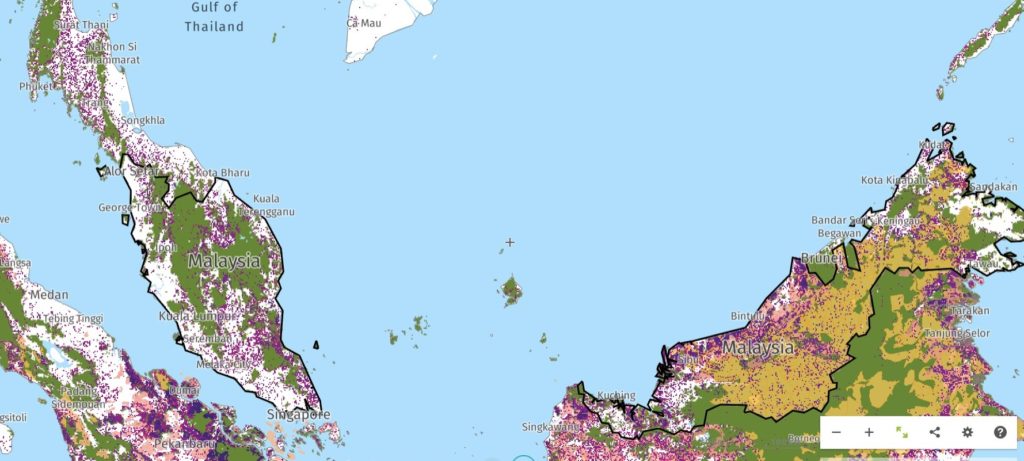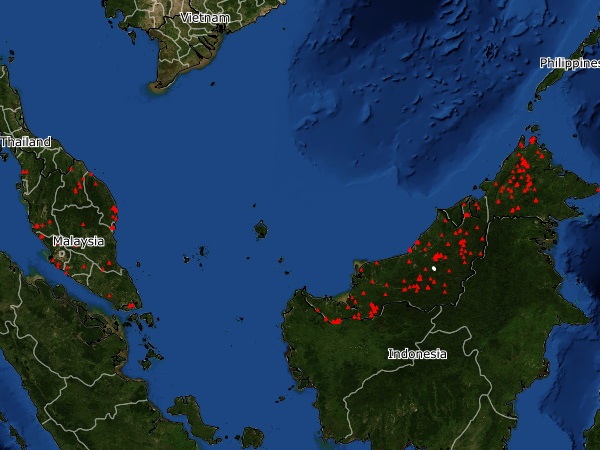
KUALA LUMPUR, Aug 10 – There were more than 100,000 forest change alerts and 329 fire alerts reported in Malaysia including in the states of Sabah and Sarawak for the past one week by external sources, namely Global Forest Watch and NASA FIRMS.
Regular reports of open fires was also reported by the Department of Environment (DOE) in the same week, some attributed to the current hot spell, although many were also confirmations of fire complaints made by the public and environmentalists long before the hot and dry spell.
These were fires taking place during cool, rainy days and with the additional “help” from the Movement Control Orders (MCOs) and Enhanced MCOs where supposedly very little activities were allowed and traffic was significantly reduced, said an environmentalist.
The question is how many of these fires were investigated properly and where are the full explanations of what were causing these fires?
“The chances are the department may not have enough resources and there is more that should come from the Ministry of Environment and Water as well as other ministries such as the Ministry of Agriculture and Food Industries as some of the open burnings are done for agricultural purposes,” said naturalist Andrew Sebastian.
“The DOE has been doing its part by way of issuing warnings and spelling out the consequences of open burnings from time to time,” he said.
The fines and penalties are there. But are these measures sufficient?
DOE, which said 418 open burning cases were detected in July, also expects the number to rise if hot and dry weather conditions continue until mid-term September 2021.
It also issued a total of 358 compounds, 72 instructional notices and opened 9 investigative papers for open burning offences under Section 29 A, Environmental Quality Act, 1974 [ACT 127] from January to July 22, this year and that it has increased open burn and enforcement activity on factory and motor vehicles.
It also continued to highlight the consequences of compromised air quality on the health of people, pointing out that that carbon dioxide and other toxic gases released in the air during fires will not help the Covid-19 situation.
While stale indoor air with high concentration of Carbon (CO2) contributes to risk of getting infected by airborne viruses, including the Covid-19, it is established that the air outside also contributes to ill human health.
Many local communities are also contributing to keeping the environment clean, but all these measures may not be enough if there is an absence of integrated action, Andrew reiterated.
The Fire Department and State Forest Department must work together to ensure a more holistic approach towards safeguarding the environment.
“Currently, the scenario is if you call on a fire happening in a forest, the standard DOE reply is that it is not their area but that of the forest department and that they should be contacted. Sometimes, the complainant will be directed to the fire department. When will the fires in the country be collectively addressed by all agencies responsible for the care of the environment,” asked another environmentalist.
“For example, a fire that was ongoing in Sepang earlier in June was reported. It was claimed to be a peat fire and several weeks later, a report on the DOE’s Facebook said the fire was investigated and that if was found to have been started in the backyard of someone’s house and this somewhat spread to the area. The event was reported more than a month before that but DOE report on the same issue was made a month late.
“It could have put off the fire earlier and the area is probably now burnt beyond rehabilitation,” he said.
The DOE has to go beyond giving reports on how many fires are happening and how this situation will get worse with the current dry and hot spell or that warnings have been issued for open burnings. It has to take more preventive actions.
“It is not fire alone that the DOE has to look into. The cutting down of trees, the clearing of land for industrial purposes, mining purposes are also contributing to environmental pollution, and DOE must also have a say on this. It cannot say that the area belongs to the Fire Department or the state authorities.
“The current method of slapping fines is not sufficient, especially with big companies clearing the land for commercial reasons. Malaysia’s weather has never experienced forest fires or peat fires in the decades before. Why is it happening now? Most of the time, it starts as an open burning and spreads to the forest areas .”

Meanwhile, according to Global Forest Watch (GFW), an online platform that provides data and tools for monitoring forests, there were more than 105,132 GLAD deforestation alerts during the period July 26 to Aug 2. These alerts came from intact forest, primary forest, peat and protected areas.
Each GLAD alert indicates a 30 by 30 meter area (around the size of two basketball courts) that has experienced a disturbance in the forest canopy, which indicates that trees in that area may have been lost or removed.
According to GFW, Malaysia had 20.3 million hectares of natural forest in 2010, extending over 87% of its land area. In 2020, it lost 122,000 hectares of natural forest, equivalent to 85.2 million tonnes of CO₂ of emissions.
In 2010 Selangor had 306kha of natural forest, extending over 67% of its land area. In 2020 alone, it lost 836ha of natural forest, equivalent to 478kt of CO₂ of emissions.
For the period July 23 to July 30, there were 22 GLAD alerts reported in Selangor.
In 2010, Pahang had 2.01 million hectares of natural forest, extending over 89% of its land area. In 2020 alone it lost 22,000 hectares of natural forest, equivalent to 16.2Mt of CO₂ of emissions.
Between July 23 and July 30 this year, there were 4,375 GLAD deforestation alerts in Pahang with 1.6 percent of them being high confidence alerts.
According GFW, GLAD alerts become “high confidence” when loss is detected in multiple Landsat images.
In 2010, Perak had 1.09 million hectares of natural forest, extending over 83% of its land area. In 2020 alone, it lost 4,009 hectares of natural forest, equivalent to 3.09Mt of CO₂ of emissions.
During the period July 23 to July 30, there were 460 GLAD deforestation alerts with 2.8 percent of them being high confidence alerts.
—